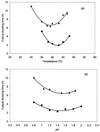Enumeration and characterization of acidophilic microorganisms isolated from a pilot plant stirred-tank bioleaching operation
- PMID: 12676667
- PMCID: PMC154788
- DOI: 10.1128/AEM.69.4.1936-1943.2003
Enumeration and characterization of acidophilic microorganisms isolated from a pilot plant stirred-tank bioleaching operation
Abstract
Microorganisms were enumerated and isolated on selective solid media from a pilot-scale stirred-tank bioleaching operation in which a polymetallic sulfide concentrate was subjected to biologically accelerated oxidation at 45 degrees C. Four distinct prokaryotes were isolated: three bacteria (an Acidithiobacillus caldus-like organism, a thermophilic Leptospirillum sp., and a Sulfobacillus sp.) and one archaeon (a Ferroplasma-like isolate). The relative numbers of these prokaryotes changed in the three reactors sampled, and the Ferroplasma isolate became increasingly dominant as mineral oxidation progressed, eventually accounting for >99% of plate isolates in the third of three in-line reactors. The identities of the isolates were confirmed by analyses of their 16S rRNA genes, and some key physiological traits (e.g., oxidation of iron and/or sulfur and autotrophy or heterotrophy) were examined. More detailed studies were carried out with the Leptospirillum and Ferroplasma isolates. The data presented here represent the first quantitative study of the microorganisms in a metal leaching situation and confirm that mixed cultures of iron- and sulfur-oxidizing prokaryotic acidophiles catalyze the accelerated dissolution of sulfidic minerals in industrial tank bioleaching operations. The results show that indigenous acidophilic microbial populations change as mineral dissolution becomes more extensive.
Figures






References
-
- Bradford, M. M. 1976. A rapid and sensitive method for the quantitation of microgram quantities of protein utilizing the principle of protein-dye binding. Anal. Biochem. 72:248-254. - PubMed
-
- Brierley, C. L. 1997. Mining biotechnology: research to commercial development and beyond, p. 3-17. In D. E. Rawlings (ed.), Biomining: theory, microbes and industrial processes. Springer-Verlag/Landes Bioscience, Georgetown, Tex.
-
- Dew, D. W., E. N. Lawson, and J. L. Broadhurst. 1997. The BIOX process for biooxidation of gold-bearing ores or concentrates, p. 45-80. In D. E. Rawlings (ed.), Biomining: theory, microbes and industrial processes. Springer-Verlag/Landes Bioscience, Georgetown, Tex.
Publication types
MeSH terms
Substances
Associated data
- Actions
- Actions
- Actions
- Actions
LinkOut - more resources
Full Text Sources
Other Literature Sources
Molecular Biology Databases

